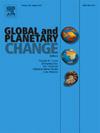中国西北部库车凹陷北部的年代学、构造和盐构造:对新生代天山隆升和前陆变形的影响
IF 4
1区 地球科学
Q1 GEOGRAPHY, PHYSICAL
引用次数: 0
摘要
地表过程(如侵蚀、沉积)和深部地质过程(如板块流变、挠曲和运动学)在不同时间尺度上的耦合影响塑造了前陆褶皱和推力带。这些过程记录了造山演化的多个阶段,对于理解造山运动与沉积盆地填充之间的相互作用至关重要。在本文中,我们在库卡凹陷北部进行了一项综合研究,包括出露地层的磁地层学、详细的实地调查和地下地震剖面解释。这项研究旨在通过考察与盐有关的构造来阐明天山的构造隆升。目前的研究结果表明,研究地区的断裂活动始于始新世早期,至少持续到中新世晚期。值得注意的是,自∼5.3Ma以来,图齐玛扎断裂带由于区域收缩而受到严重挤压。出露的生长地层主要是压缩性地层,而不是卤化性地层,这表明图齐马扎反斜坡自中新世晚期(5.3Ma∼)以来发生了横向扩张。这种扩张是对印度-欧亚碰撞远场效应的反应。我们认为,天山的局部活化可能始于渐新世早期(34 Ma),随后的三次变形分别发生在24 Ma、10 Ma和5.3 Ma。早期的变形可归因于库车坳陷北部的基底隆起,而始于 5.3 Ma 的后期变形则反映了整个前陆更密集的变形,表明天山在稳步向外发展。所有这些构造事件共同促成了现代天山的形成。本文章由计算机程序翻译,如有差异,请以英文原文为准。
Chronology, structures and salt tectonics in the northern Kuqa Depression, NW China: Implications for the Cenozoic uplift of Tian Shan and foreland deformation
Foreland fold-and-thrust belts (FTBs) are shaped by the coupled influence of surface processes (e.g., erosion, sedimentation) and deep geological processes (e.g., plate rheology, flexure and kinematics) across various timescales. These processes record multiple phases of orogenic evolution and are crucial for understanding the interplay between mountain building and the sedimentary basin filling. In this paper, we conducted an integrated study including magnetostratigraphy of exposed strata, detailed field investigations and interpretations of subsurface seismic profiles in the northern Kuqa Depression. This study aims to elucidate the tectonic uplift of the Tian Shan by examining salt-related structures. The present findings reveal that diapirism in the study area commenced in the early Eocene and continued at least into the late Miocene. Notably, the Tuzimaza diapir has been significantly squeezed due to regional contraction since ∼5.3 Ma. The exposed growth strata were primarily compressional, rather than halokinetic, suggesting the lateral expansion of the Tuzimaza anticline since the latest Miocene (∼5.3 Ma). This expansion was a response to the far-field effects of the Indian-Eurasian collision. We propose that the local activation of the Tian Shan likely initiated in the early Oligocene (∼34 Ma), with three subsequent episodes of deformation occurring ∼24 Ma, ∼10 Ma and ∼ 5.3 Ma. The earlier episodes can be attributed to basement uplift in the northern Kuqa Depression, whereas the later episode starting at ∼5.3 Ma reflects more intensive deformation across the entire foreland, indicative of the steady outward growth of the Tian Shan. Collectively, all these tectonic events have contributed to the formation of the modern Tian Shan.
求助全文
通过发布文献求助,成功后即可免费获取论文全文。
去求助
来源期刊

Global and Planetary Change
地学天文-地球科学综合
CiteScore
7.40
自引率
10.30%
发文量
226
审稿时长
63 days
期刊介绍:
The objective of the journal Global and Planetary Change is to provide a multi-disciplinary overview of the processes taking place in the Earth System and involved in planetary change over time. The journal focuses on records of the past and current state of the earth system, and future scenarios , and their link to global environmental change. Regional or process-oriented studies are welcome if they discuss global implications. Topics include, but are not limited to, changes in the dynamics and composition of the atmosphere, oceans and cryosphere, as well as climate change, sea level variation, observations/modelling of Earth processes from deep to (near-)surface and their coupling, global ecology, biogeography and the resilience/thresholds in ecosystems.
Key criteria for the consideration of manuscripts are (a) the relevance for the global scientific community and/or (b) the wider implications for global scale problems, preferably combined with (c) having a significance beyond a single discipline. A clear focus on key processes associated with planetary scale change is strongly encouraged.
Manuscripts can be submitted as either research contributions or as a review article. Every effort should be made towards the presentation of research outcomes in an understandable way for a broad readership.
 求助内容:
求助内容: 应助结果提醒方式:
应助结果提醒方式:


